You’ll remember that, about a year ago, Canadian astronomers announced the discovery of a small asteroid sharing the earth’s orbit.
The asteroid in question, 2010 TK7, is a “planetary Trojan” – an object sharing an orbit with a planet.
While Earth only has one such companion (that we know of), the giant planets Jupiter and Neptune are accompanied by vast swarms of these objects. Both likely host at least a million Trojan asteroids larger than 1km in diameter, trapped in swarms that both lead and trail the host planet in its orbit.
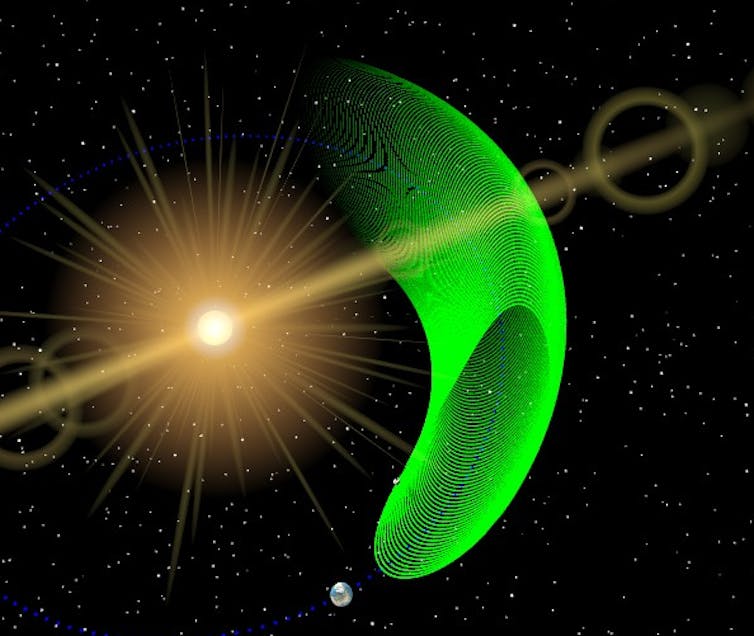
Just recently my fellow researchers and I discovered that a “Jovian” Trojan (sharing an orbit with Jupiter) discovered in 1930, (1173) Anchises, is actually unstable – that is, it will eventually escape from Jupiter’s grasp to roam the wider solar system.
More on Anchises and the significance of our discovery in a moment. But first, a bit of background …
The Jovian Trojans
Of the populations of Trojans in our solar system, the Jovian Trojans are by far the best studied. The first Jovian Trojan found, (588) Achilles, was discovered way back in 1906.
As such, you might expect we’ve had plenty of time to work out everything there is to know about the way these objects formed and how they behave. In reality, the more we study them, the more surprises are thrown our way.
Perhaps the most surprising characteristic of the Jovian Trojans is the great variety of orbits they possess. Unlike the planets, which move in orbits that are relatively circular and almost lie in exactly the same plane, the Jovian Trojans include objects moving on orbits that are inclined by almost 60º to the plane of the solar system.
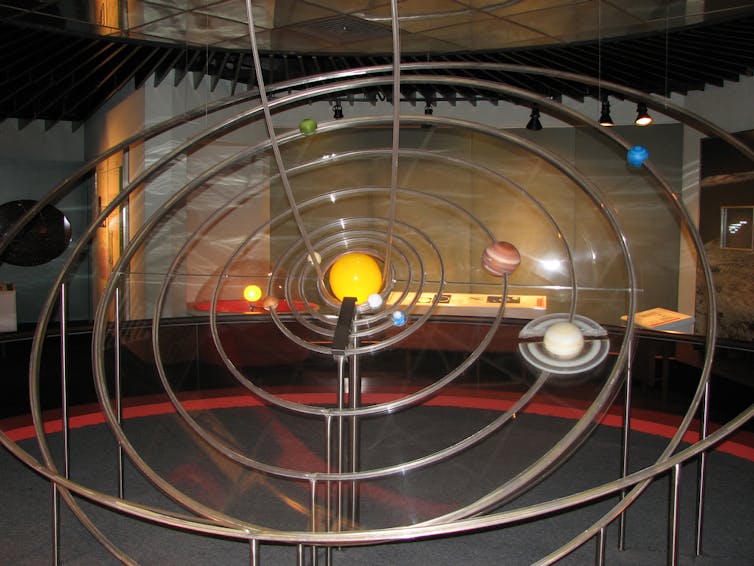
Other Trojans move on orbits so eccentric that, at their furthest distance from the sun, they are more than 50% further away than at their closest (such as asteroid (40237), which ranges between 4.07 and 6.36 times the distance from Earth to the sun).
The key to understanding this unexpectedly “puffed up” population of objects lies in understanding how our solar system formed and then evolved into its current state.
The formation of Jupiter’s Trojans
The reason there are so many objects in Jupiter’s Trojan clouds is that orbits within those clouds are dynamically stable – once an object is moving on one of those orbits, the chances are it will stay there for billions of years.
This stability is the reason we have large populations of Trojans in the first place. But it also poses a problem for astronomers.
The evolution of objects under gravity – their so-called “dynamical evolution” – is a time-reversible process. If an object can be transferred from one orbit to another purely under the influence of gravity, then the reverse transfer is also possible.
Because the Trojans are thought to be highly dynamically stable, this means it’s very unlikely a given Trojan will be ejected from the Trojan cloud. So if you were to return to the solar system in a billion years, the Trojan clouds would look pretty much as they do today.
This becomes a problem when you consider how the Trojans got there in the first place.
If it’s very hard for objects to escape the region, then it is equally very hard for objects to be captured to that region. And so the most simple explanation for the presence of the Trojan clouds would seem to be that the Trojans formed in those clouds, and have remained there ever since.

Growing Trojans
The sticking point with this “in-situ” hypothesis is the distribution of Trojan orbits. It’s now well accepted that our planetary system (as well as the many exoplanetary systems being discovered) formed from a disk of material around the youthful sun.
Such disks (called protoplanetary disks) are known to be very dynamically cold. In other words, they are very thin and consist of gas and dust moving on orbits that are very close to circular, and lie in the same plane.
Several studies – including one by my colleagues and I - have shown a number of problems with forming the Jovian (and Neptunian) Trojan populations in-situ from such a disk.
Two of these, in particular, stand out:
1) Studies of in-situ Trojan formation have repeatedly shown their accretion (the process by which objects form through collisions between small grains of dust and ice) would be too inefficient to produce a large number of Trojans before the protoplanetary disk is blown away by the youthful and hyperactive sun.
2) More troublesome for the theory of in-situ formation, the Trojan populations formed in those studies always have very dynamically cold properties.
In other words, Trojans formed in this manner move on orbits that are essentially circular, and all lie within, at most, a couple of degrees of the plane of the solar system. This is in stark contrast to the highly excited clouds of Trojans we observe in our own solar system, with many Trojans moving on highly inclined and relatively eccentric orbits.
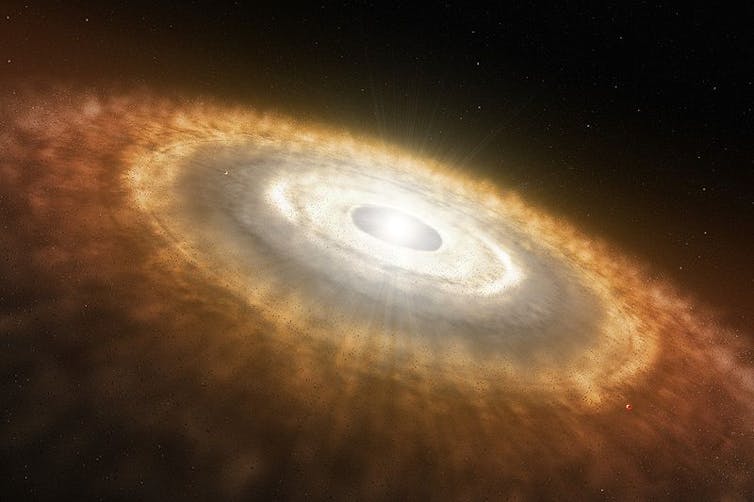
We therefore have a problem: the Trojans can’t have formed in-situ.
But the Trojan clouds are so dynamically stable that securely capturing even a few Trojans from the population of unstable objects that whizz around the outer solar system seems highly unlikely. Capturing a population that possibly numbers in the millions seems even more unlikely.
Wandering planets
Fortunately, in the last ten or 15 years, a solution to this problem has gradually been revealed.
Through a combination of detailed studies of our own solar system, and the discovery of a wide variety of exoplanetary systems vastly different to our own, it’s now widely accepted that giant planets migrate over vast distances, both during and after their formation, before coming to rest in their final orbits.
In our own solar system, a key piece of evidence for this migration is the objects known as the Plutinos. These objects are named after the first member discovered, the dwarf planet 134340 Pluto.
These objects, which orbit the sun beyond the orbit of Neptune, have many similarities with the Trojans. They move on orbits that can be highly inclined and highly eccentric, with many on paths that cross the orbit of Neptune.
They are protected from ever encountering that planet by the action of a “mean-motion resonance”. That is, the Plutinos orbit the sun twice in the time it takes Neptune to complete three orbits. This means that whenever a Plutino crosses the orbit of Neptune, Neptune is always far away from the crossing point.
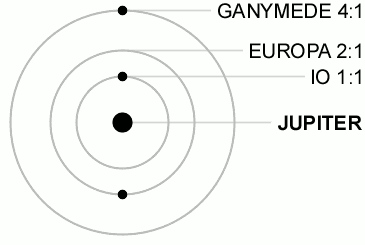
Studies of the formation of our solar system have shown that the Plutinos are a population of objects that were captured into resonant orbits by Neptune, as the giant planet migrated outwards through the solar system.
As the planet migrated, the resonance swept outward before it and acted a bit like a broom, collecting a huge number of objects and pushing them along with it. As the Plutinos were carried along by the resonance, they were pushed on to ever-more-eccentric and inclined orbits.
As a result, it is possible, to some extent, to work out how far Neptune migrated by the degree to which the Plutinos have been moved off simple, same-plane orbits.
It turns out Neptune migrated outward by at least one billion kilometres (seven times the distance between Earth and the sun), gathering Plutinos as it moved.
Further migration
Neptune was certainly not the only giant planet in our solar system to migrate. The other giants, too, will undoubtedly have moved significant distances before coming to rest at their current locations.

This migration holds the key to the origin of their Trojan populations.
As Jupiter migrated inwards, Saturn was also migrating through the outer solar system. Eventually, the two planets reached a separation where they began to strongly interact with one another, destabilising each other’s orbits. This destabilisation would also have strongly destabilised the Jovian Trojan clouds.
Once those regions became unstable, it became very easy for the solar system’s small bodies to pass through those regions. Equally, any objects “trapped” in those clouds would easily escape.
This process resulted in a vast amount of material – the debris from which the planets were forming – sleeting through the Trojan region on all manner of orbits.
Eventually, Jupiter and Saturn migrated away from an arrangement in which they were strongly perturbing one another. At that time the Trojan clouds became the dynamically stable places we see today.
As a result, the population of objects that was passing through the Trojan clouds as they transitioned back to stability was frozen in, the objects trapped on now-stable orbits.
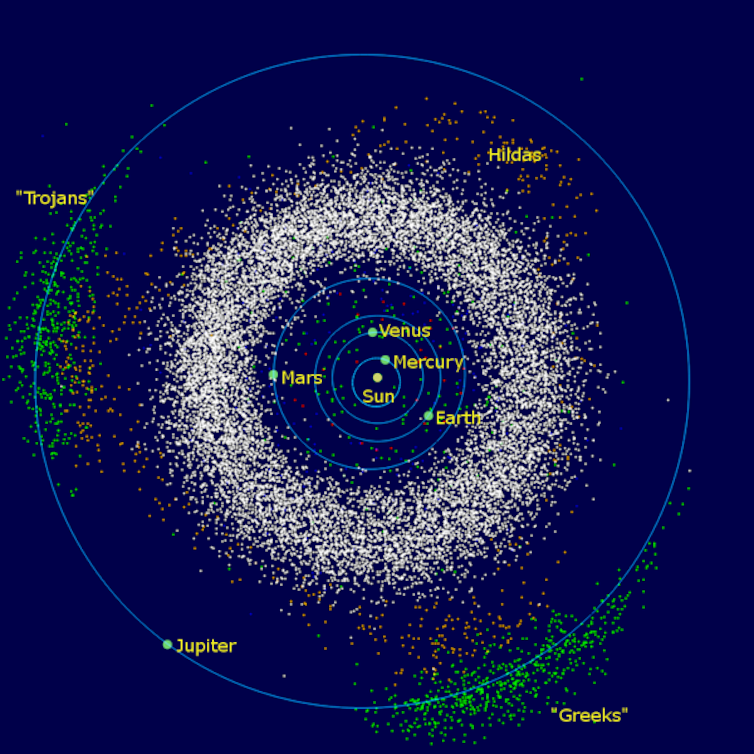
Unstable objects in the outer solar system (the short and long-period comets and the Centaurs) move on orbits with a wide range of inclinations and eccentricities (the result of their ongoing chaotic encounters with the planets that continually sling-shot them to new orbits).
This means that new Trojans captured from those populations would also move on a wide range of orbital inclinations and eccentricities. Just like the populations we observe today.
Here’s one we prepared earlier …
If this “capture model” of Trojan formation is true, one would expect Trojans to be captured with a range of stabilities. Some objects would be captured to orbits right on the edge of the region of stability, while others would be captured to the most stable regions.
In other words, if the Trojans were captured, we should expect a small fraction of them to be dynamically unstable, albeit with relatively long lifetimes. As time passed, the unstable Trojans would gradually bleed away from the clouds, leaving a population that appears ever more stable.
Which brings me back to the discovery made by our team. As mentioned, we have now identified one such unstable Trojan. In fact, it’s the first Jovian Trojan to be shown to be dynamically unstable.
1173 Anchises was the ninth Jovian Trojan to be discovered, in 1930. It moves on a moderately eccentric orbit, inclined to the plane of the solar system by almost 7º. In all respects, it appears to be a typical Jovian Trojan.
In order to study the behaviour of Anchises, we carried out a highly detailed computational simulation of its orbital evolution.

We created a vast swarm of almost 20,000 “clones” of Anchises, with each clone initially moving on a very slightly different orbit. All of these different orbits agreed with the orbit published for the asteroid, within its observational uncertainties.
We then followed the motion of these Anchises clones in our simulated solar system for 4 billion years.
If the Trojan was totally dynamically stable, one would expect that all (or almost all) the test particles would still be trapped in the Trojan cloud at the end of the simulations.
Remarkably, though, half of the clones were ejected from the solar system (or collided with one of the planets!) within the first 350 million years of the simulation. By the end, just 224 clones remained in the Jovian Trojan cloud - a survival fraction of scarcely more than 1%.
Such a survival rate is entirely compatible with the idea that (1173) Anchises is one of the last survivors of a once-greater population of unstable Trojans, captured by Jupiter during its migration, but not held tightly enough to be truly dynamically stable.
We also found that (1173) Anchises is physically unusual. Using data collected by the infra-red space observatories IRAS, Akari and WISE, we found that (1173) Anchises is one of the darkest objects in the solar system, reflecting just 2.7% of the light that falls upon it.
(An object’s reflectivity, so to speak, is known as its “albedo”. The earth, by contrast, has an albedo of roughly 30%.)
But what does it all mean?
Our discovery of (1173) Anchises’ instability is one more piece of evidence in support of the idea that the Jovian Trojans are a captured, rather than pre-formed, population.
It is also further evidence (if any was needed) that the giant planets did indeed migrate in their youth and that the solar system was not always the placid and stable place it appears to be today.
At the same time, our discovery also poses many interesting questions. If (1173) Anchises is a captured object, where did it form?
Is it an object that formed closer to the sun, that was captured as it escaped from the inner solar system? Or did it form much further from the sun, in the icy depths of the outer solar system?
As always, there’s much more to learn.

